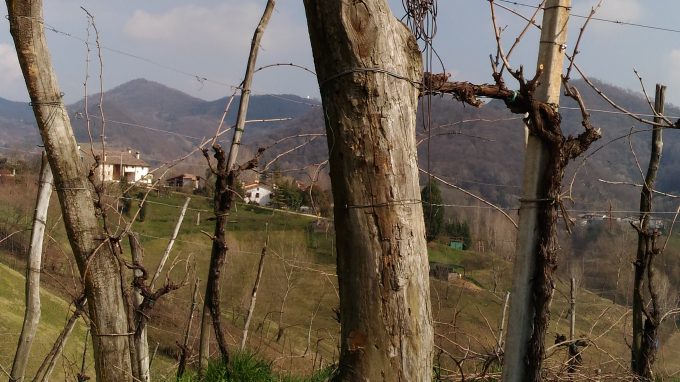'Live from the Langhe & Roero' DBGitalia connects classic Italian fine wine producers with U.K. & Worldwide importers & distributors

Published
4 May 2018
Tags
Brrrr! News from Nord Italia: Biondelli, Monte dei Ragni, Bele Casel, & Marco Sara
Just back from a March 2018 tour of DBGitalia’s (battered) northern Italian producers…
Lombardia’s Joska Biondelli was still feeling bruised having lost 70% of his (Franciacorta) Chardonnay crop in April 2017’s frost, only to be then battered by the subsequent breakage of 6,000 bottles of his brand new, 100% Pinot Nero 2016 Franciacorta Rosé ‘Donna Clemy’, named after his nonna/grandmother. Fortunately, Joska’s fidanzata Francesca galloped to the rescue in November, saving the day & vintage by agreeing to marry him! This will mean that later this year, unsurprisingly, the remaining 1,000 bts of his 2013 ‘Donna Clemy’ will be hit hard, not by inclement weather, but by the wedding party…so best place your order soon! In the meantime, his (2015) Brut is looking Bello & biscuity, sboccato/disgorged in Nov’17 after 18 months on the lees/sur lattes, while the (2014) Satèn is cool verbena & satiny, the product of only the first light pressing.
Further east, Venetian Zeno Zignoli at Monte dei Ragni has also been hit: this time by two difficult vintages in succession, 2013 & 2014, compelling him to make the difficult decision of not producing his prized Amarone Classico in either vintage! This had a knock-on effect on his Valpolicella Classico Superiore, that therefore lacked the ‘Ripasso’ dimension in both vintages. That said, the Valpolicella Classico Superiore effectively became ‘super-Valpolicelle’ or ‘baby-Amarone’, enhanced by the fruit that would have gone into the Amarone. Indeed in the case of 2013 vintage, Zeno actually picked & dried the fruit for Amarone but then at the last minute, chose to declassify it all to Valpolicella. Whereas in the 2104 vintage, he didn’t even bother to pick for Amarone & dry the fruit; he just harvested it all as a fresh & surprisingly good Valpolicella Classico Superiore. The exciting news is that he invested in two new 15HL Garbellotto botti grandi to house his 2015 Amarone Classico!
Among the Asolo hills, Prosecco producers Bele Casel were also ‘burnt’ by April 2017’s frost, reducing their yield by up to 20%. That’s not as bad as the 30% lost to the frost by the 600 million bottle Prosecco market, mostly to plantings on the plains! Unbowed, Bele Casel’s Ferraro family continues to focus on high quality, organic Glera, Manzoni, Bianchetta, Perera, Boschera & Rabbiosa grapes from the hilly Asolo villages of Cornuda, Maser & Monfumo (hit hard in 2017 alas). Their new Extra Brut (4 grams RS) continues the trend for drier Prosecco, even among the US market. While later this year/early next, they will be releasing two new wines: Asolo Prosecco Colfondo ‘Quindici’, a special, vintage bottling & label that celebrates the pretty cassis fruit of the successful 2015 vintage. And then there’s ‘Uve Vecchie’, a (2017) Asolo Prosecco that blends the above 6 ancient Prosecco varieties from across their 10 hectares, which has been aged for 12 mths in tank….a dry wine that sings of prati del montagne/mountain meadows!
And finally I caught up with Friulani Marco & Sandra Sara, along with their boys Pietro & Tobias, who are making scintillating wines from their 7ha of vineyards, nestled in the comune of Povoletto among the hills of Colli Orientali del Friuli close to Udine. They were spared the frosty horrors, or heat, of 2017, but alas rain spoiled play as they harvested the Ribolla Gialla; (Tocai) Friulano came in earlier so was saved. Clearly the ‘ponca/flysch’ soils (ancient sedimentary seabed shale) that underpins the Colli Orientali del Friuli helps define their Friulano, Schioppettino & Picolit grapes, giving a real energy & racy tension to the wines. This attribute manifests itself as the wines age, providing a spine of minerality & clarity. Indeed the 2013 Friulano possessed the sapidity of a Caol’Ila Islay Malt Whisky, along with riper white currant notes; while the 2013 Schioppettino showed a coiled, gleaming core of Pinot esque rosehip fruit & nervous energy! In the pipeline is a possible ‘ponca’/terroir driven blend of indigenous varieties: Verduzzo, Ribolla Gialla & of course Friulano!